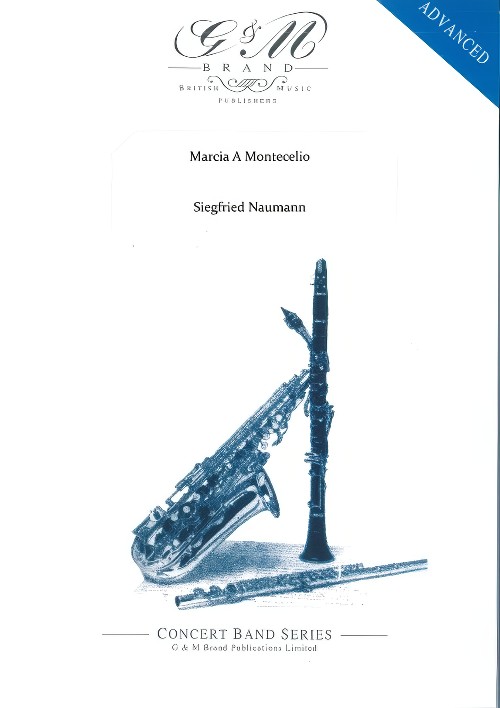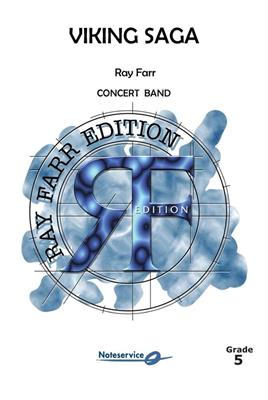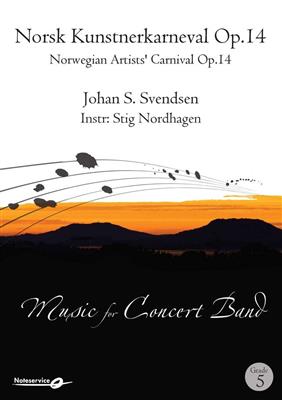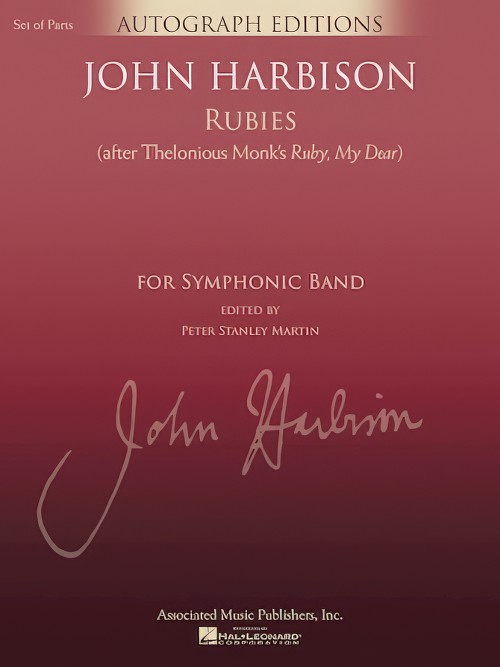Results
-
 £74.95
£74.95Marcia A Montecelio (Concert Band - Score and Parts) - Naumann, Siegfried
Monticello is the name of a little place northeast of Rome where my wife and I have rented a simple home for more than 20 years. We participated intensively in the cultural life of the community where there was also a little band, the Banda Municipale Cornicolana, which consisted of about 55 wind players, mostly youngsters. One day, the "Il Direttore" came to me and asked if I would like to write a march for them, which I naturally did. It became the Marcia a Montecelio. After 14 rehearsals, with everyone tired, perspiring and red in the face, we were forced to give up. The march was too difficult for them. I then wrote another, easier march for them to perform at the forthcoming feast of San Michaeli. The Montecelio march was composed on pure inspiration in just two days. It is written in the Italian style - with a pinch of Sousa.
Estimated dispatch 7-14 working days
-
 £14.95
£14.95Marcia A Montecelio (Concert Band - Score Only) - Naumann, Siegfried
Monticello is the name of a little place northeast of Rome where my wife and I have rented a simple home for more than 20 years. We participated intensively in the cultural life of the community where there was also a little band, the Banda Municipale Cornicolana, which consisted of about 55 wind players, mostly youngsters. One day, the "Il Direttore" came to me and asked if I would like to write a march for them, which I naturally did. It became the Marcia a Montecelio. After 14 rehearsals, with everyone tired, perspiring and red in the face, we were forced to give up. The march was too difficult for them. I then wrote another, easier march for them to perform at the forthcoming feast of San Michaeli. The Montecelio march was composed on pure inspiration in just two days. It is written in the Italian style - with a pinch of Sousa.
Estimated dispatch 7-14 working days
-
 £205.30
£205.30Mitt hjerte alltid vanker - Fantasi - Hans Adolph Brorson
This arrangement was commissioned by B3 (The Bergen Woodwind Ensemble). B3 is a large woodwind ensemble located in Bergen with a mix of professional and amateur players. My Heart Remains in Wonder is a well-known Christmas hymn in Scandinavia. I wanted my version to be different to the traditional hymn tune style in which it is normally performed. One day I was outside walking and this idea came to me: an ostinato-like, mechanical skeleton of arpeggio semiquavers on which I could 'hang' the melody. However, I also wanted to do the melody line a bit different. The inspiration for this comes from folk music and the way fiddlers hardly ever lift their bow off the strings when they play. Because of this, it is important that the melody is played in a very sostenuto style in this arrangement. The harmonies lie somewhere between jazz and folk music with a little nod towards Grieg (himself heavily influenced by folk music) in the slow middle section.
Estimated dispatch 7-14 working days
-
 £183.20
£183.20Viking Saga - Ray Farr
"Viking Saga" was inspired by my conducting engagements in Norway in the 1980s. Among them was a visit to the Flekkefjord Pike Korps who asked me to write a piece for them. I had just written "Adventures in Brass" which was very popular, particularly with younger bands, so I decided to pursue the creative energy. My teacher, at that time, was Professor Edward Gregson who encouraged me to develop my ideas into a full-scale work. The piece received a few performances in this version but neither I, nor my teacher, were satisfied so the manuscripts lay dormant. In the summer of 2002 a band from Switzerland- Cordula Brass Baden and Christoph Moor, who had played the piece under mydirection in the Swiss National Youth Band, commissioned me to finish the work and make the changes that, I felt, were needed. In 2016 the Tnsberg Wind Band, from Norway, commissioned a wind band version for their performance in the Norwegian Championships held in Trondheim 2017.
Estimated dispatch 7-14 working days
-
 £218.30
£218.30Norsk Kunstnerkarneval Op.14 - Johan S. Svendsen
This well-known work was composed in Christiania in 1874 for a burlesque Carnival in "Kunstnerforeningen".An early title for the work was "Bryllup paa Dovre". The manuscript score and parts at The National Library in Oslo of the early version with this title have much more music than the version printed by C.F. Peters, Leipzig in 1881. The form in this first version was ABA with an additional trio part that later were discarded. In the trio Svendsen used the melody Sterreisen (Os har gjort kva gjeras skulle) from Lindeman's collection of Norwegian Folk Tunes. (Vol. I/115). In the A-part a wedding tune (Bruraslaatten) from Sogn is used (Lindeman Vol. I/476). The Carnival's literary theme was the connection between the cold north and the warm south. Musically the south is represented in Svendsen's music by Raffaele Sacoo's melody from 1835 "Te voglio bene assai".I believe that if Norwegian quality music from this period is going to be performed, it must at least be available. There must be editions for modern instrumentations with full scores. I do this as my contribution to expand and enrich the repertoire for Concert Bands.- Stig Nordhagen -
Estimated dispatch 7-14 working days
-
£202.99
Porco Rosso - Joe Hisaishi
From the 1992 Japanese animated film about an Italian World War I flying ace who, for a wartime misdeed, was transformed into an anthropomorphic pig. The flamboyant post-war story of Porco Rosso (Crimson Pig) battling air pirates is full of intrigue and romance, and the film's diverse and lush soundtrack is one of the more rare Studio Ghibli scorings. Mr. Tomoki Ubata, (band director at Ina Gakuen Sr. High School) assisted with medley design as we both became intrigued with the music.The sixth song, Kyouki ~ hishou (insanity & soaring), appearing on Joe Hisaishi's album "My Lost City", is often performed for his concerts. Due to its complexity I am sure this is one of Hisaishi's favorites. I also added the French chanson "Le Temps des cerises" (Antoine Renard) that Madame Gena sings in the film. This is my favorite of all chansons; I was happy to include this bittersweet, beautiful melody.The following themes are contained in the arrangement:1. Le Temps des cerises2. Jidai no kaze (Wind of the Times)3. Mammaito4. Pikkoro no onnatachi (Women of Piccolo)5. Porco e Bella6. Kyouki ~ hishou (Insanity & Soaring)7. Tooki jidai o momomede (Seeking for Far Times)You can hear how the story folds without a screen.(Kazuhiro Morita)
Estimated dispatch 7-14 working days
-
 £109.99
£109.99Rubies (After Thelonious Monk's Ruby, My Dear) (Concert Band - Score and Parts) - Harbison, John - Martin, Peter Stanley
Composer John Harbison writes: "Rubies is a version of Thelonious Monk's Ruby, My Dear, which he composed while still in his teens. When I was invited by the Seattle Symphony to make a short piece reflecting my first musical passions, my thoughts were of Bach and Monk. Since I had recently made some Bach-like chorale preludes, I chose to make a version of Monk's tune, first in a chamber-musical, contrapuntal manner, then in the grand orchestral style I had always heard lurking there." Duration: 5:30 (Recorded live by the Rutgers Symphony Band - Peter Stanley Martin, guest conductor)
Estimated dispatch 7-14 working days
-
 £109.99
£109.99Rubies (After Thelonious Monk's Ruby, My Dear) - John Harbison
Composer John Harbison writes: 'Rubies is a version of Thelonious Monk's 'Ruby, My Dear', which he composed while still in his teens. When I was invited by the Seattle Symphony to make a short piecereflecting my first musical passions, my thoughts were of Bach and Monk. Since I had recently made some Bach-like chorale preludes, I chose to make a version of Monk's tune, first in a chamber-musical, contrapuntal manner, then inthe grand orchestral style I had always heard lurking there.' Dur: 5:30 (Recorded live by the Rutgers Symphony Band - Peter Stanley Martin, guest conductor).
Estimated dispatch 7-14 working days
-
£13.95
Dreamscapes
1-4DreamscapesMartin EllerbyRoyal Northern College of Music Wind Orchestra I. Eldorado 6.09 II. Avalon 4.00 III. Shangri-La 2.43 IV. Xanadu! 3.325RailWilfred JosephsRoyal Northern College of Music Wind Orchestra9.296-9Euphonium ConcertoMartin EllerbySteven Mead (Euphonium) with Royal Northern College of Music Wind Orchestra I. Fantasy 7.02 II. Capriccio 3.35 III. Rhapsody (for Luis) 6.41 IV. Diversions 5.0810-12Mata HariNigel ClarkeRoyal Northern College of Music Wind Orchestra I. Dancer in the Shadows 4.16 II. Deceit and Seduction 6.26 III. Evasion and Capture 5.0613MeditationsMartin EllerbyRoyal Northern College of Music Wind Orchestra12.50
Estimated dispatch 7-14 working days
-
£13.95
Wind Borne
1Heroic MarchPercy Fletcher arr. Philip SparkeRoyal Northern College of Music Wind Orchestra5.402-7The Cries of LondonMartin EllerbyRoyal Northern College of Music Wind Orchestra I. Dawn Watch 1.48 II. Westminster Chimes 2.29 III. A Dream or Two (A Song for London) 3.46 IV. Catch that Catch Can Kenneth Boyd (Tenor)2.24 V. Evening Watch 1.39 VI. Hymn 4.268Diversions (Epitaph for a Dreamer)Darrol BarryRoyal Northern College of Music Wind Orchestra10.489-11Leading EdgeRob WiffinRoyal Northern College of Music Wind Orchestra I. Prelude 3.43 II. Sicilana 3.34 III. Finale 4.3412Wind BorneAvner HananiRoyal Northern College of Music Wind Orchestra7.1013Dragon DanceDuncan StubbsRoyal Northern College of Music Wind Orchestra5.0314-16Fanfares and CelebrationsNigel ClarkeRoyal Northern College of Music Wind Orchestra I. Intrada 5.54 II. Processional 5.40 III. Jubilate 4.41
Estimated dispatch 7-14 working days
